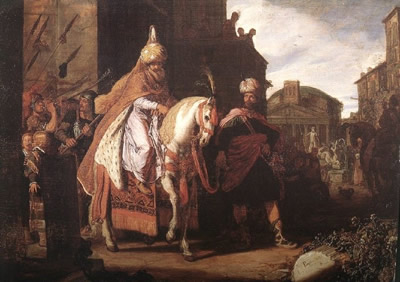|
Rembrandt and The Purim Story
By Helen Webberley
The problematic canonicity of The Book of Esther in the Christian world has been canvassed in a number of places (Webberley 2002). In the annual letter in 367 AD, the Patriarch of Alexandria listed the canon of scripture. His version was very close to the Protestant Old Testament, excluding Book of Esther, Wisdom of Solomon and Judith and Tobit. The most explicit definition of the Catholic Canon, that DID include the Book of Esther, wasn't given until 1546 by the Council of Trent. Luther rejected the Book of Esther totally. Calvin and Zwingli had greater problems with the Book of Revelation, but they were also not overly fond of Esther
Between 1624-1685, Rembrandt and his students and colleagues painted and etched scenes from the Book of Esther. They took their themes from various stages in the Esther story, intense, full of imminent danger, sometimes highly decorative. What was the endless appeal of this slightly obscure, historically questionable (in Christian eyes) Jewish story to the Christian artists?
One of the first Dutch artists who painted a Purim image was Pieter Lastman (1583-1633). His Amsterdam group shared a dedication to history painting, often employing biblical subjects that, until then, had been relatively rare in Netherlandish art eg The Triumph of Mordechai 1624, Rembrandt House (see image at begining of article) and Haman Pleads to Esther for Mercy. Rembrandt was deeply influenced by Lastman's iconography.
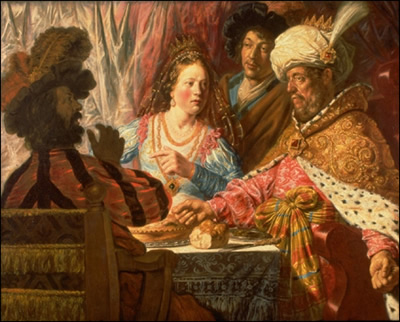
Lievens - Feast of Esther
Jan Lievens (1607-74) was a pupil of Pieter Lastman, and a close friend of Rembrandt. In The Feast of Esther c1625 Raleigh NC (see image), Lievens selected the moment when Esther revealed Haman's treacherous
plot for the destruction of her people. As she pointed towards the traitor, the king reacted in anger with fists clenched. In his wrath, he ordered Haman to be hanged. Haman, isolated in shadow at the left, responded in fear, with mouth open.
One of Rembrandt Harmenszoon van Rijn (1606-69)'s earliest surviving etchings on the theme may have been the image The Great Jewish Bride 1635, Oxford. Seated in state, complete with document in hand, it has been proposed by David Wavre (1996) that the correct title was Esther with the Decree for the Destruction of the Jews.
The Triumph of Mordechai c1641 Rembrandthuis was an interesting view of Haman leading Mordechai through Shushan. Mordechai was arrayed in royal robes and escorted through the city streets on a magnificent horse, in reward for having uncovered the plot against the life of the king. The evil Haman was forced to publicly honour Mordechai.
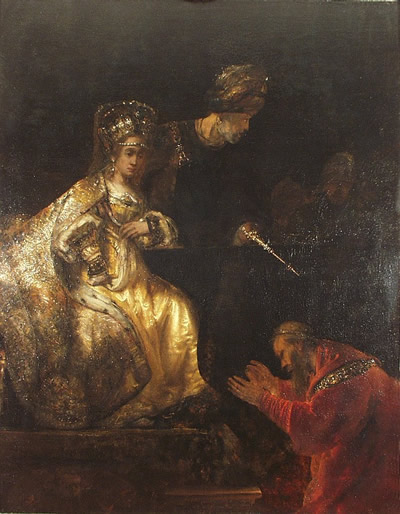
Rembrandt - Haman Begging Esther for Mercy
Rembrandt painted a very dark image of Haman Begging Esther for Mercy 1655, Bucharest (see image), down on his knees, grovelling before Queen Esther. The king was to the side of his wife, condemning Haman with a sceptre pointed threateningly at his prime minister's head.
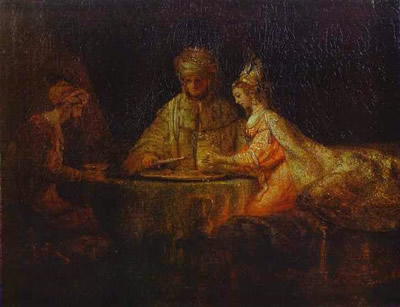
Rembrandt - Achashverosh, Esther and Haman at Banquet
Rembrandt's painting Achashverosh, Esther and Haman at the Banquet 1660 Pushkin (see image) was insightful in the psychological depth of the diners and the light gleamed through the dim atmosphere. The dramatic conflict between the three people was expressed through their restrained but tense gestures. Esther was luminous; her robe and long train were beautiful. Haman was wrapped in shadow. Rembrandt had clearly tapped into the characters' inner life.
In Haman Sets Forth to honour Mordechai, c1665, Hermitage, a very thoughtful Rembrandt showed the dastardly Haman, hoisted on his own petard. He had encouraged King Achashverosh to pay enormous honour to an important citizen, thinking it was going to be himself, then was forced to honour his mortal enemy instead. It was a moment of forced and miserable humbleness for the ambitious prime minister.
When Rembrandt died in 1669, he was buried in Westerkerke. The Jews of Amsterdam wept the day Rembrandt died: they had lost a friend.
Govert Flinck (1615-60) went to Amsterdam to work with the Master as a journeyman in 1632-5. One of the earliest signed works was a portrait of Manasseh ben Israel 1637! Had Flinck seen Rembrandt's works? Certainly he absorbed Rembrandt's sensitivity to family ties.

Victors - Esther and Haman Before Acheshverosh
Jan Victors (1616-76), who studied with Rembrandt in the 1630s, created art that was very much influenced firstly by the Master and then by Govert Flinck. Victors painted mostly large Old Testament scenes, apparently for Calvinist patrons. He first painted Esther and Haman before Achashverosh in c1639, Cologne (see image), where the older king patiently waited while Esther and Haman traded accusations. Esther was leaning forward in her earnestness; Haman moved back in shock, as if stunned that someone would hurt him.
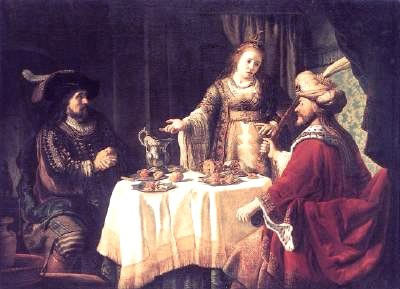
Victors - Banquet of Esther and Achashverosh
Victors later repeated the same Purim moment, but the setting was lighter, brighter, better furnished. In Banquet of Esther and Achashverosh c1645, Kassel (see image), Haman watched slyly whilst Esther told her tale over the tabletop. This time the king was not patient; he had grabbed his sceptre and shook it tensely at Haman.
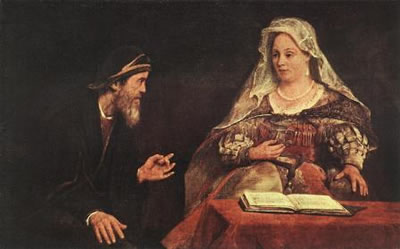
Gelder - Esther and Mordechai
Aert de Gelder (1645-1727) came from Dordrecht to study in 1661-7, the last of the young men who learned in Rembrandt's studios. de Gelder was the pupil who stayed most faithfully to the Rembrandt style, particularly with regard to Old Testament dramas. Esther and Mordechai 1685 Budapest (see image) showed Mordechai telling his niece what she must do to save her people. The dark background, fiery colours and broad brush work were all taken from Rembrandt.
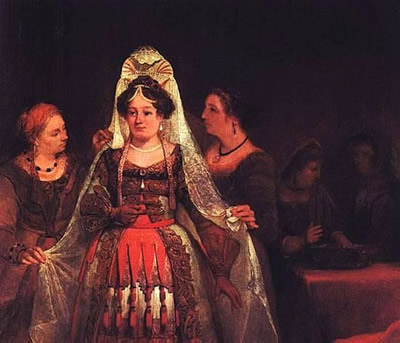
Gelder - Queen Esther Adorned by Her Maids
He also painted two very similar versions of the maids dressing and preparing the young queen. In Esther Being Clad in Her Finery c1685, Potsdam and Esther Adorned by Her Maids 1684, Munich (see image), de Gelder captured the subject when Esther was being prepared for her dangerous meeting with Achashverosh. The risks were enormous: de Gelder showed the young queen gravely hiding her fear, surrounded by anxious courtiers. The opulent colours and materials were familiar.
In de Gelder's King Achashverosh Condemning Haman c1680 Melbourne, the king had fascinating oriental headgear and clothes, and an amazing dagger. Did de Gelder see Rembrandt's version of Haman Begging for Mercy, painted in 1655. Apart from the very dark, fierce nature of the both works, the de Gelder king pulled an extremely nasty weapon. Haman could barely be seen, hiding in the gloom.
de Gelder painted another Esther scene that was closely tied to the biblical text, but was an unusual moment to select. After Haman had been hanged on the gallows, Mordechai and Esther still needed to revoke the king's orders to kill the Jewish people. No royal proclamations could be rescinded, but the king allowed Esther and Mordechai to write whatever they wished to the Jews, in the king's name and with the royal seal. In Esther and Mordechai Write the Second Purim Letter c1690, Providence, Mordechai was working on the letter.
But all these Dutch examples beg the question: what was the artists' interest in a minor Old Testament story that most people would have barely recognised? Calvinist collectors in the Dutch Republic WERE often very interested in Old Testament art; Calvin had advocated careful study of the biblical narrative, from both Testaments equally. But a general interest in Biblical stories does not explain why the Book of Esther was popular, in particular. There have been three main reasons offered to explain the popularity of the Purim story:
For continuation, go to Page Two
* * * * *
For more Purim Articles, see our Purim Archives
~~~~~~~
from the February 2008 Edition of the Jewish Magazine
|










